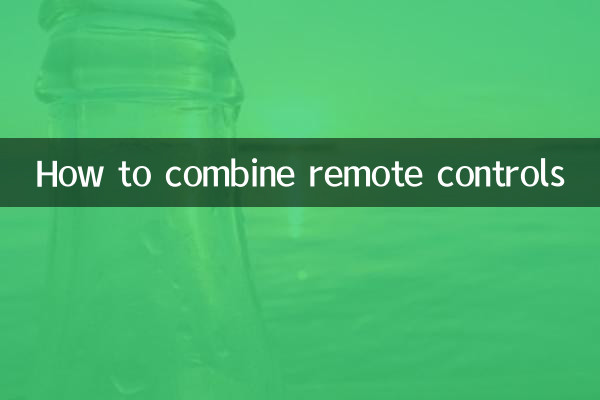Title: How to merge remote controls? The ultimate solution to the smart home era
With the popularity of smart home devices, the number of remote controls in homes has surged, including TVs, air conditioners, audio, set-top boxes... Each device is equipped with a remote control, which not only takes up space, but is also easy to be confused. How to merge multiple remotes into one? This is one of the hot topics on the Internet recently. This article will combine popular discussions and data from the past 10 days to provide you with structured solutions.
1. Why do you need to merge the remote control?

According to netizens’ feedback and e-commerce platform data, too many remote controls have become a common pain point for smart home users. The following is the hot topics discussed in the past 10 days:
| topic | Discussion count (items) | Hot search index |
|---|---|---|
| What to do if there are too many remote controls | 12,500 | 85 |
| Recommended universal remote control | 8,200 | 72 |
| Mobile phone replacement remote control | 15,300 | 91 |
2. Comparison of mainstream merger plans
By analyzing the evaluation of technology forums and e-commerce platforms, we have sorted out the advantages and disadvantages of three mainstream remote control merge solutions:
| Program Type | Representative products | advantage | shortcoming | User rating (5-point scale) |
|---|---|---|---|---|
| Physical universal remote control | Broadlink RM4 Pro | Strong compatibility, no network required | Need to learn the keys manually | 4.3 |
| Mobile APP control | Mi Family/Tmall Elf | No extra equipment required, interface friendly | Rely on the Internet and mobile phones | 4.1 |
| Voice Control Center | Amazon Echo | Free your hands and intelligently link | Need support for supporting equipment | 4.6 |
3. Specific operating guide
1. Use the universal remote control:
(1) Purchase a universal remote control that supports infrared learning
(2) Enter the learning mode and enter the original remote control button one by one
(3) Save settings and test functions
2. Mobile APP control plan:
(1) Download the smart home APP (such as Mijia and Tmall Elf)
(2) Add infrared transmitter equipment
(3) Add remote control templates for each electrical appliance in the APP
(4) Custom control interface
4. Latest technical trends
According to the last 10 days of technology media reports, the following innovative technologies may change the way remote controls are used:
| Technical name | R&D institutions | Estimated commercial time | Core advantages |
|---|---|---|---|
| UWB precise positioning remote control | Apple/Samsung | 2024 | Directional control, no need to align the device |
| AI prediction control | 2025 | Automatically predict user needs |
5. Real user feedback
Collected from e-commerce platforms and social media:
| User Type | Preferences | Main considerations |
|---|---|---|
| Young tech enthusiasts | Mobile APP + voice control | Intelligent degree |
| Middle-aged and elderly users | Physical universal remote control | Easy to operate |
| Rentals | Portable infrared emitter | Easy to install |
6. Purchase suggestions
1. Consider equipment compatibility: Confirm whether the appliance model to be controlled supports it
2. Evaluate usage scenarios: multi-functional remote control is recommended in the living room, and voice control is suitable for the bedroom.
3. Pay attention to expansion capabilities: choose a solution that supports subsequent addition of new devices
4. Budget planning: The price of physical remote control is generally between 100-300 yuan, and the intelligent center is about 500-1,000 yuan.
Conclusion:
The merger of remote controls has become a key link in smart home optimization. Whether choosing a traditional universal remote control, mobile APP control or emerging voice interaction solution, the core is to create a more convenient user experience for users. With the advancement of technology, we may be able to completely bid farewell to the physical remote control in the future and usher in a smarter home control method.

check the details

check the details